“加拿大原住民电影和文化”研讨会
作者:杜发春、张小敏
日期:2008-09-18
浏览次数:5128
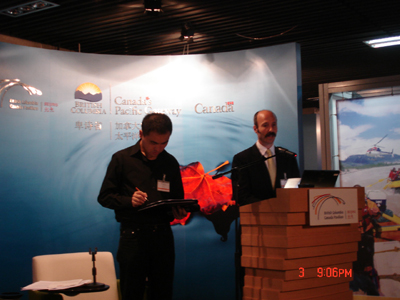
高柏灵参赞(右)代表加拿大政府致辞
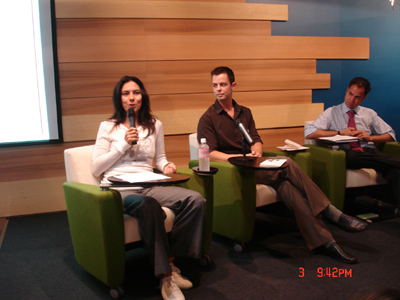
左起:Gail Maurice,Adam Garnet Jones,Arjun Vinodrai
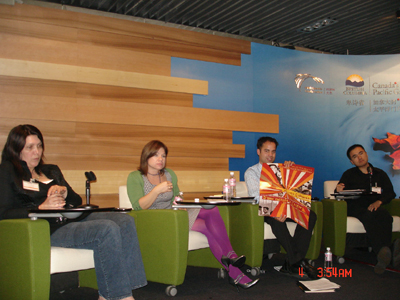
左起:Loretta Todd,Laura Milliken,Arjun Vinodrai
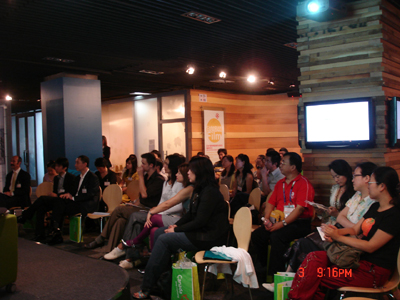
从当代视角体验加拿大原住民电影和文化
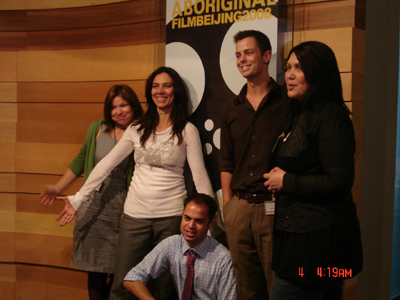
加拿大原住民导演
2008年 9月4日,由加拿大驻华大使馆主办的“从当代视角体验加拿大原住民电影和文化”研讨会在北京规划展览馆“不列颠哥伦比亚省-加拿大厅”召开。加拿大驻华大使馆公共事务参赞高柏灵(Patrice Cousineau)先生代表加拿大政府致辞。会上放映了6部反映当代加拿大原住民的影视短片。来自加拿大的4位原住民导演与中国相关学者和影视界专家就原住民影视片和原住民文化进行了深入的交流。研讨会由加拿大文化遗产部韦诺戴(Arjun Vinodrai)先生主持。参加此次活动的中加两国专家学者共有71人。
高柏灵参赞代表加拿大政府对来自加拿大的原住民电影导演、制片人和莅临的各位中国嘉宾表示热烈的欢迎。他说,在过去的四个多月中,不列颠哥伦比亚省-加拿大展厅高朋满座,汇聚了中加两国艺术家、教育者、学者和商界人士等等,通过所有这些交流活动结成的纽带,将促进两国之间的长期合作和友谊。高柏灵参赞指出,加拿大为其国家在物质和人文地理方面的极其多元化而感到骄傲。加拿大历史上的各种做法得出的经验和教训,使我们认识到应推行多元文化主义,重视、保护和包容文化多样性。这就需要妥协和对话。加拿大人已经认识到,如果我们不重视保护我们所创造的文化遗产,国家的整体实力将会削弱。相反,如果我们包容这些文化遗产,我们的国家作为一个整体,其实力就增强了。只有对其历史、独特性和其在社会中的地位感到自信的个人,才能够有能力建设自己的社区,并实现自己的目标。尽管如此,目前还存在许多挑战,诸如在当代社会中文化认同的失落,缺少机会和贫困等。加拿大政府正在与原住民合作,来保证他们拥有所需的工具,来处理自己的事务,来培养有自决权利和能力的原住民和原住民社区组织。例如,通过2007年开始推行的《都市原住民战略》,加拿大政府将在五年内拨款6850万加元,来满足原住民居住在大城市中心的需要,确保原住民有更多的途径获得在大城市成功生活的技能和经验。加拿大政府还采取措施来改善原住民的教育。在不列颠哥伦比亚省,2006年签署了一项协议,旨在使第一民族能有效地管理和控制课程设置、标准、学校和教师资格等。类似的改进教育效果的措施在其他省也在进行之中。
高柏灵参赞强调,此次所放映的影视片以深刻的洞察力展示了当代原住民的许多现实情况,希望借此对上述问题有机会得到反映,当然,更重要的是大家能够欣赏到原住民创造力的真实影像表达。高参赞还希望影片放映后,大家能在开放和友谊的精神下,从各自不同的角度来讨论加中两国原住民和少数民族面临的重要问题,比如城市化对文化认同的留存所带来的挑战、语言和文化丧失的潜在问题等等。
来自加拿大的影片导演亚当•加尼特•琼斯 (Adam Garnet Jones)先生、盖尔•莫利斯 (Gail Maurice)女士、劳拉•米利肯 (Laura Milliken)女士和洛雷塔•托德(Loretta Todd)女士,分别与参会代表见面,四位年轻的导演介绍了影片并回答了与会中国专家学者提出的问题。
会上放映了6部反映当代加拿大原住民的影视短片,分别是《拨开云层》、《熏烟》、《我不是你想象中的印第安人》、《城市长老》、《代代相传》、《圣地》等。上述影视短片集中反映了当代原住民广泛的经历,展现了他们数千年来口述故事的传统。电影运用了各种美学风格和概念方法,描述了加拿大原住民的各种语言、文化和经历的独特故事。据有关研究,原住民的祖先大约在500年前开始与欧洲人接触,之后经历了重大的变迁,包括文化和语言的丢失。为了纠正过去的不公正现象,加拿大已做了大量的工作,但是这个过程还远远没有结束。后殖民语境为新一代有才华的原住民电影制作人提供了以冷嘲式幽默来讲述他们自己故事的肥沃土壤。这些年轻的电影制作人利用祖先的记忆、先进的技术以及全球文化概念和美学的影响来反映加拿大原住民的当代现实。此次展映活动为与会者提供了一次体验具有开创性的原住民电影新浪潮的机会。
参加此次原住民电影和文化研讨的中国有关机构有:中国社会科学院民族学与人类学研究所、中国社会科学院社会学研究所、中国社会科学院世界宗教研究所、中央民族大学、清华大学、北京师范大学、中国传媒大学、北京教育考试院、北京教育学院、北京零频道广告有限公司、知识产权出版社等。与会中国专家学者对加拿大原住民的电影和文化表示出很大的兴趣,看完影片后,中国学者与加拿大原住民导演进行了较深入的对话和交流,所提出的问题涵盖了加拿大原住民的文化认同和文化保护,原住民电影的资金筹措、制作、发行,原住民导演的个人经历等。与会代表还参观了正在北京规划展览馆展出的“不列颠哥伦比亚--加拿大厅”。
(中国社会科学院民族所加拿大研究中心杜发春、张小敏 供稿)
Contemporary Perspectives on Canadian Aboriginal Film and Culture
A special event, Contemporary Perspectives on Canadian Aboriginal Film and Culture: A Selection of Contemporary Film and Video from Canada’s Aboriginal Communities, which was organized by the Canadian Embassy of China, has held at the BC-Canada Pavilion(BCCP) in the Beijing Planning Exhibition Hall in Beijing, China on 4th of September, 2008. On behalf of the Embassy of Canada in China, Mr. Patrice Cousineau, the Counsellor and Head for Public Affairs, addressed the opening remarks. There are more than 70 participants from both Canada and China attended the event, among which, 4 young Aboriginal filmmakers from Canada. This event was chaired by Mr. Arjun Vinodrai from the Department of Canadian Heritage.
In his opening remarks, Mr. Cousineau said that the BCCP has been a point of convergence in Beijing for Chinese and Canadian cultural actors, educators, academics, business-people and more over the last 4 months. I am confident that the ties created through these exchanges will nurture enduring cooperation and friendships. He pointed out that Canada prides itself on being a country that is extremely diverse, both in terms of physical and human geography. Through trials and errors during our history, we have learned to celebrate multiculturalism, to value, maintain and embrace cultural diversity. This has required compromise and dialogue. Canadians have understood that if we diminish the cultural heritage of our people, our country as a whole is diminished. Yet when we embrace the same heritage, our country as a whole is strengthened. Individuals, confident in their history, their uniqueness, and in their place in society are those best equipped to build their communities and realize their goals. However, many challenges remain. Issues relating to loss of cultural identity in a contemporary setting, lack of opportunities and poverty, among other. The Canadian government is working with Aboriginal peoples to ensure they have the tools they need to take charge of their own affairs and to foster self-reliant individuals and communities. For example, through the Urban Aboriginal Strategy in 2007, $68.5 million were set aside on a five-year initiative to help respond to the needs of Aboriginal peoples living in key urban centres and ensure that Aboriginal Canadians have greater access to the skills and experiences they need to succeed in an urban setting. The Government has also taken action to improve education for Aboriginal Canadians. In British Columbia, an agreement was signed in 2006 that enables First Nations to assume meaningful control over areas such as curriculum, standards, school and teacher certification. Similar approaches to improving education outcomes in other provinces are under way.
Mr. Cousineau emphasized that today’s screenings provide insights into a number of realities of contemporary Aboriginal people. I hope this will be an opportunity to reflect on a few of these issues but also to enjoy true expressions of Aboriginal creativity. He hoped that through the film screenings and exchanges, some important questions which aboriginal and minority populations in Canada and in China face will be discussed in a spirit of openness and friendship, so that we may learn from our respective situations. Questions revolving around the challenges that urbanization presents to the maintenance of cultural identity, and the implications of loss of language and culture.
In the one-day event, 4 Canadian Aboriginal film directors, including Mr. Adam Garnet Jones, Ms. Gail Maurice, Ms. Laura Milliken and Ms. Loretta Todd, showcased and discussed with Chinese counterparts. 6 Aboriginal films, such as Cloud-breaker, Smudge, The Peoples Go on, I am Not the Indian You Had in Mind, Urban Elder and Writing the Hand, exhibited and dubuted to Chinese audience, which represented a range of contemporary Aboriginal experiences and resonate with an oral storytelling tradition that is thousands of years old. They use a variety of aesthetic styles and conceptual approaches to tell unique stories that reflect the diverse languages, cultures and experiences of Canada’s Aboriginal peoples. It is studied that these are the stories of the descendants of those who suffered drastic change, including loss of culture and language, after contact with Europeans, which began some 500 years ago. Much has been done to redress the injustices of the past, but this process is far from over. Our current post-colonial context provides fertile ground for a talented new generation of Aboriginal filmmakers empowered to tell their own stories, often with a wry sense of humour. These young filmmakers draw upon ancestral memory, evolving technologies, and the conceptual and aesthetic influences of global culture to reflect the myriad of contemporary realities of Canada’s original people. This program offered a glimpse into the ground-breaking new wave of Aboriginal cinema.
Over 70 participants attended this event, 10 of which came from Canada including 4 Canadian filmmakers, others from the Department of Canadian Heritage, and the Canadian Embassy in Beijing. Chinese attendees came from the Chinese National Academy of Social Sciences, Beijing Normal University, Tsinghua Universiy, Central University for Nationalities, and Communication University of China, etc.
(Provided by ZHANG Xiaomin and DU Fachun, CASS)
高柏灵参赞代表加拿大政府对来自加拿大的原住民电影导演、制片人和莅临的各位中国嘉宾表示热烈的欢迎。他说,在过去的四个多月中,不列颠哥伦比亚省-加拿大展厅高朋满座,汇聚了中加两国艺术家、教育者、学者和商界人士等等,通过所有这些交流活动结成的纽带,将促进两国之间的长期合作和友谊。高柏灵参赞指出,加拿大为其国家在物质和人文地理方面的极其多元化而感到骄傲。加拿大历史上的各种做法得出的经验和教训,使我们认识到应推行多元文化主义,重视、保护和包容文化多样性。这就需要妥协和对话。加拿大人已经认识到,如果我们不重视保护我们所创造的文化遗产,国家的整体实力将会削弱。相反,如果我们包容这些文化遗产,我们的国家作为一个整体,其实力就增强了。只有对其历史、独特性和其在社会中的地位感到自信的个人,才能够有能力建设自己的社区,并实现自己的目标。尽管如此,目前还存在许多挑战,诸如在当代社会中文化认同的失落,缺少机会和贫困等。加拿大政府正在与原住民合作,来保证他们拥有所需的工具,来处理自己的事务,来培养有自决权利和能力的原住民和原住民社区组织。例如,通过2007年开始推行的《都市原住民战略》,加拿大政府将在五年内拨款6850万加元,来满足原住民居住在大城市中心的需要,确保原住民有更多的途径获得在大城市成功生活的技能和经验。加拿大政府还采取措施来改善原住民的教育。在不列颠哥伦比亚省,2006年签署了一项协议,旨在使第一民族能有效地管理和控制课程设置、标准、学校和教师资格等。类似的改进教育效果的措施在其他省也在进行之中。
高柏灵参赞强调,此次所放映的影视片以深刻的洞察力展示了当代原住民的许多现实情况,希望借此对上述问题有机会得到反映,当然,更重要的是大家能够欣赏到原住民创造力的真实影像表达。高参赞还希望影片放映后,大家能在开放和友谊的精神下,从各自不同的角度来讨论加中两国原住民和少数民族面临的重要问题,比如城市化对文化认同的留存所带来的挑战、语言和文化丧失的潜在问题等等。
来自加拿大的影片导演亚当•加尼特•琼斯 (Adam Garnet Jones)先生、盖尔•莫利斯 (Gail Maurice)女士、劳拉•米利肯 (Laura Milliken)女士和洛雷塔•托德(Loretta Todd)女士,分别与参会代表见面,四位年轻的导演介绍了影片并回答了与会中国专家学者提出的问题。
会上放映了6部反映当代加拿大原住民的影视短片,分别是《拨开云层》、《熏烟》、《我不是你想象中的印第安人》、《城市长老》、《代代相传》、《圣地》等。上述影视短片集中反映了当代原住民广泛的经历,展现了他们数千年来口述故事的传统。电影运用了各种美学风格和概念方法,描述了加拿大原住民的各种语言、文化和经历的独特故事。据有关研究,原住民的祖先大约在500年前开始与欧洲人接触,之后经历了重大的变迁,包括文化和语言的丢失。为了纠正过去的不公正现象,加拿大已做了大量的工作,但是这个过程还远远没有结束。后殖民语境为新一代有才华的原住民电影制作人提供了以冷嘲式幽默来讲述他们自己故事的肥沃土壤。这些年轻的电影制作人利用祖先的记忆、先进的技术以及全球文化概念和美学的影响来反映加拿大原住民的当代现实。此次展映活动为与会者提供了一次体验具有开创性的原住民电影新浪潮的机会。
参加此次原住民电影和文化研讨的中国有关机构有:中国社会科学院民族学与人类学研究所、中国社会科学院社会学研究所、中国社会科学院世界宗教研究所、中央民族大学、清华大学、北京师范大学、中国传媒大学、北京教育考试院、北京教育学院、北京零频道广告有限公司、知识产权出版社等。与会中国专家学者对加拿大原住民的电影和文化表示出很大的兴趣,看完影片后,中国学者与加拿大原住民导演进行了较深入的对话和交流,所提出的问题涵盖了加拿大原住民的文化认同和文化保护,原住民电影的资金筹措、制作、发行,原住民导演的个人经历等。与会代表还参观了正在北京规划展览馆展出的“不列颠哥伦比亚--加拿大厅”。
(中国社会科学院民族所加拿大研究中心杜发春、张小敏 供稿)
Contemporary Perspectives on Canadian Aboriginal Film and Culture
A special event, Contemporary Perspectives on Canadian Aboriginal Film and Culture: A Selection of Contemporary Film and Video from Canada’s Aboriginal Communities, which was organized by the Canadian Embassy of China, has held at the BC-Canada Pavilion(BCCP) in the Beijing Planning Exhibition Hall in Beijing, China on 4th of September, 2008. On behalf of the Embassy of Canada in China, Mr. Patrice Cousineau, the Counsellor and Head for Public Affairs, addressed the opening remarks. There are more than 70 participants from both Canada and China attended the event, among which, 4 young Aboriginal filmmakers from Canada. This event was chaired by Mr. Arjun Vinodrai from the Department of Canadian Heritage.
In his opening remarks, Mr. Cousineau said that the BCCP has been a point of convergence in Beijing for Chinese and Canadian cultural actors, educators, academics, business-people and more over the last 4 months. I am confident that the ties created through these exchanges will nurture enduring cooperation and friendships. He pointed out that Canada prides itself on being a country that is extremely diverse, both in terms of physical and human geography. Through trials and errors during our history, we have learned to celebrate multiculturalism, to value, maintain and embrace cultural diversity. This has required compromise and dialogue. Canadians have understood that if we diminish the cultural heritage of our people, our country as a whole is diminished. Yet when we embrace the same heritage, our country as a whole is strengthened. Individuals, confident in their history, their uniqueness, and in their place in society are those best equipped to build their communities and realize their goals. However, many challenges remain. Issues relating to loss of cultural identity in a contemporary setting, lack of opportunities and poverty, among other. The Canadian government is working with Aboriginal peoples to ensure they have the tools they need to take charge of their own affairs and to foster self-reliant individuals and communities. For example, through the Urban Aboriginal Strategy in 2007, $68.5 million were set aside on a five-year initiative to help respond to the needs of Aboriginal peoples living in key urban centres and ensure that Aboriginal Canadians have greater access to the skills and experiences they need to succeed in an urban setting. The Government has also taken action to improve education for Aboriginal Canadians. In British Columbia, an agreement was signed in 2006 that enables First Nations to assume meaningful control over areas such as curriculum, standards, school and teacher certification. Similar approaches to improving education outcomes in other provinces are under way.
Mr. Cousineau emphasized that today’s screenings provide insights into a number of realities of contemporary Aboriginal people. I hope this will be an opportunity to reflect on a few of these issues but also to enjoy true expressions of Aboriginal creativity. He hoped that through the film screenings and exchanges, some important questions which aboriginal and minority populations in Canada and in China face will be discussed in a spirit of openness and friendship, so that we may learn from our respective situations. Questions revolving around the challenges that urbanization presents to the maintenance of cultural identity, and the implications of loss of language and culture.
In the one-day event, 4 Canadian Aboriginal film directors, including Mr. Adam Garnet Jones, Ms. Gail Maurice, Ms. Laura Milliken and Ms. Loretta Todd, showcased and discussed with Chinese counterparts. 6 Aboriginal films, such as Cloud-breaker, Smudge, The Peoples Go on, I am Not the Indian You Had in Mind, Urban Elder and Writing the Hand, exhibited and dubuted to Chinese audience, which represented a range of contemporary Aboriginal experiences and resonate with an oral storytelling tradition that is thousands of years old. They use a variety of aesthetic styles and conceptual approaches to tell unique stories that reflect the diverse languages, cultures and experiences of Canada’s Aboriginal peoples. It is studied that these are the stories of the descendants of those who suffered drastic change, including loss of culture and language, after contact with Europeans, which began some 500 years ago. Much has been done to redress the injustices of the past, but this process is far from over. Our current post-colonial context provides fertile ground for a talented new generation of Aboriginal filmmakers empowered to tell their own stories, often with a wry sense of humour. These young filmmakers draw upon ancestral memory, evolving technologies, and the conceptual and aesthetic influences of global culture to reflect the myriad of contemporary realities of Canada’s original people. This program offered a glimpse into the ground-breaking new wave of Aboriginal cinema.
Over 70 participants attended this event, 10 of which came from Canada including 4 Canadian filmmakers, others from the Department of Canadian Heritage, and the Canadian Embassy in Beijing. Chinese attendees came from the Chinese National Academy of Social Sciences, Beijing Normal University, Tsinghua Universiy, Central University for Nationalities, and Communication University of China, etc.
(Provided by ZHANG Xiaomin and DU Fachun, CASS)
文章来源:杜发春